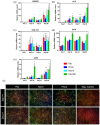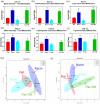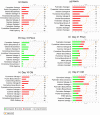Biomimetic oyster shell-replicated topography alters the behaviour of human skeletal stem cells
- PMID: 30202512
- PMCID: PMC6124183
- DOI: 10.1177/2041731418794007
Biomimetic oyster shell-replicated topography alters the behaviour of human skeletal stem cells
Abstract
The regenerative potential of skeletal stem cells provides an attractive prospect to generate bone tissue needed for musculoskeletal reparation. A central issue remains efficacious, controlled cell differentiation strategies to aid progression of cell therapies to the clinic. The nacre surface from Pinctada maxima shells is known to enhance bone formation. However, to date, there is a paucity of information on the role of the topography of P. maxima surfaces, nacre and prism. To investigate this, nacre and prism topographical features were replicated onto polycaprolactone and skeletal stem cell behaviour on the surfaces studied. Skeletal stem cells on nacre surfaces exhibited an increase in cell area, increase in expression of osteogenic markers ALP (p < 0.05) and OCN (p < 0.01) and increased metabolite intensity (p < 0.05), indicating a role of nacre surface to induce osteogenic differentiation, while on prism surfaces, skeletal stem cells did not show alterations in cell area or osteogenic marker expression and a decrease in metabolite intensity (p < 0.05), demonstrating a distinct role for the prism surface, with the potential to maintain the skeletal stem cell phenotype.
Keywords: Nacre; bone regeneration; osteogenic differentiation; skeletal stem cell; topography.
Conflict of interest statement
Declaration of conflicting interests: The author(s) declared no potential conflicts of interest with respect to the research, authorship and/or publication of this article.
Figures





Similar articles
-
Osteogenic potency of nacre on human mesenchymal stem cells.Mol Cells. 2015 Mar;38(3):267-72. doi: 10.14348/molcells.2015.2315. Epub 2015 Feb 5. Mol Cells. 2015. PMID: 25666352 Free PMC article.
-
Nacre Topography Produces Higher Crystallinity in Bone than Chemically Induced Osteogenesis.ACS Nano. 2017 Jul 25;11(7):6717-6727. doi: 10.1021/acsnano.7b01044. Epub 2017 Jul 5. ACS Nano. 2017. PMID: 28665112
-
Direct control of shell regeneration by the mantle tissue in the pearl oyster Pinctada fucata.J Struct Biol. 2023 Jun;215(2):107956. doi: 10.1016/j.jsb.2023.107956. Epub 2023 Mar 17. J Struct Biol. 2023. PMID: 36934975
-
Design strategies and applications of nacre-based biomaterials.Acta Biomater. 2017 May;54:21-34. doi: 10.1016/j.actbio.2017.03.003. Epub 2017 Mar 6. Acta Biomater. 2017. PMID: 28274766 Review.
-
Skeletal stem cells: phenotype, biology and environmental niches informing tissue regeneration.Mol Cell Endocrinol. 2008 Jun 25;288(1-2):11-21. doi: 10.1016/j.mce.2008.02.017. Epub 2008 Mar 4. Mol Cell Endocrinol. 2008. PMID: 18395331 Review.
Cited by
-
Effects of Fiber Cross-Angle Structures on the Mechanical Property of 3D Printed Scaffolds and Performance of Seeded MC3T3-E1 Cells.ACS Omega. 2021 Nov 30;6(49):33665-33675. doi: 10.1021/acsomega.1c04672. eCollection 2021 Dec 14. ACS Omega. 2021. PMID: 34926914 Free PMC article.
-
Injectable photosensitive bone cement enhancing angiogenesis and osteogenic differentiation for the treatment of bone nonunion.APL Bioeng. 2025 Mar 11;9(1):016114. doi: 10.1063/5.0246207. eCollection 2025 Mar. APL Bioeng. 2025. PMID: 40078866 Free PMC article.
-
Foamy oysters: vesicular microstructure production in the Gryphaeidae via emulsification.J R Soc Interface. 2020 Sep;17(170):20200505. doi: 10.1098/rsif.2020.0505. Epub 2020 Sep 30. J R Soc Interface. 2020. PMID: 32993433 Free PMC article.
-
Replication of natural surface topographies to generate advanced cell culture substrates.Bioact Mater. 2023 Jun 8;28:337-347. doi: 10.1016/j.bioactmat.2023.06.002. eCollection 2023 Oct. Bioact Mater. 2023. PMID: 37519922 Free PMC article. Review.
-
Integrating physicomechanical and biological strategies for BTE: biomaterials-induced osteogenic differentiation of MSCs.Theranostics. 2023 May 21;13(10):3245-3275. doi: 10.7150/thno.84759. eCollection 2023. Theranostics. 2023. PMID: 37351163 Free PMC article. Review.
References
-
- Dawson JI, Kanczler J, Tare R, et al. Concise review: bridging the gap: bone regeneration using skeletal stem cell-based strategies – where are we now? Stem Cells 2014; 32(1): 35–44. - PubMed
-
- Yamada Y, Nakamura S, Klein OD, et al. Current trends in stem cell therapy for improvement of bone quality. Histol Histopathol 2014; 29(6): 691–697. - PubMed
Grants and funding
- CZB/4/714/CSO_/Chief Scientist Office/United Kingdom
- MR/K026682/1/MRC_/Medical Research Council/United Kingdom
- JF20604/BB_/Biotechnology and Biological Sciences Research Council/United Kingdom
- MR/K011278/1/MRC_/Medical Research Council/United Kingdom
- BB/G008868/1/BB_/Biotechnology and Biological Sciences Research Council/United Kingdom
LinkOut - more resources
Full Text Sources
Other Literature Sources

